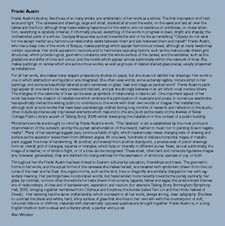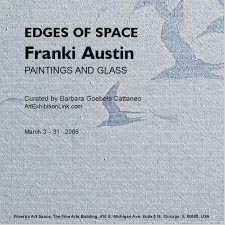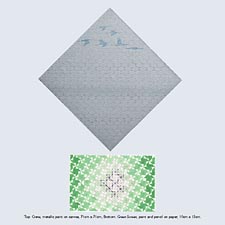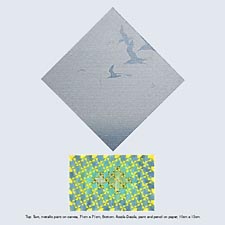


| Franki Austin Edges of Space | ||||
 | ||||
 |
 |
 |
||
 |
||||
 | ||||
 | ||||
 | ||||
 |
 |
 |
||
 |
||||
 | ||||
 | ||||
 | ||||
|
Press Release
"Everything interesting happens in the space between one thing and another; relationships between individuals, between societies, between times. These spaces - literal or metaphorical - and the edges that define them are the subject of my work." - Franki Austin A word, a verse, the whisper of flocking birds - Franki Austinís artworks on canvas and glass carry tales and myths, rooted in different cultural traditions, through time and space. Light as a breeze and still with dense and complex content, many of her works reflect the various facets of narration, the constant stream and movement of ideas, the rhythm of the world; in refined and elegant expressions, bringing together history and the present in a poetic interaction. Franki Austin catches the unseizable, floating words and tales, which are passed on from generation to generation with all the secret expectations, the elation of telling and listening, the resulting close interactive relationship between people talking about love and jealousy, pain and pleasure; about separation and reunion, life and death. She fixes these dramatic or enjoyable episodes in paintings and glass works. In her glass works the artist uses an almost alchemical method of workmanship, using acid or intense heat to transform the material. In her recent paintings, the abstraction takes over, transforming the painting into a rhythmical, pulsating composition. In some paintings birds emerge from the patterned ground, passing by on their way to unknown destinations, leaving the whisper of their wings in the air. This composition is echoed in some of her glassworks. Other paintings are based on pure abstraction. "In 2004 I came across a reference to triangles in a book on Islamic art. Amongst other meanings, a triangle is seen to give geometric expression to two entities and their reconciling relationship." Based on the triangle, Franki Austin creates patterned grids composed of geometrical, composite forms reminiscent of rotating air-screws. These picture puzzles, constantly oscillating between positive and negative, coloured and blank fields, reconcile the essential diametric opposites: all or nothing, life and death in a meditative screen, the permanent flow, the story of life.
ArtExhibitionLink Catalog Statement Franki Austinís studios, like those of so many artists, are emblematic of her work as a whole. The first impression is of radiance and light. The canvases and drawings, large and small, stacked all around the walls, on the easel and laid all over the tables and the floor, although they make walking hazardous for the visitor, are not evidence of untidiness; on closer attention, everything is carefully ordered, if informally placed; everything of the work in progress is clean, bright and shapely, the orchestrated parts of a whole. Georges Braque was quoted towards the end of his life as remarking "Objects do not exist for me except insofar as a harmonious relationship exists between them and also between them and myself." Franki Austin, who has a deep love of the work of Braque, makes paintings which appear harmonious indeed, although at many levels they contain opposites. Her work appears to reconcile and to harmonize opposing factors, such as the meticulously drawn grid structures, which provide logical, geometric constants over the whole surface of the canvas, and the variables, such as the gradations and shifts of tone and colour, and the motifs which appear almost subliminally within the network of lines. She makes paintings on canvas which are autonomous works, as well as groups of related stained glass pieces, usually presented as installations. For all her work, she makes many elegant preparatory studies on paper, but she does not exhibit her drawings. Her work is one in which abstraction and figuration are integrated. She often uses words, some as barely legible, minute script in her paintings, and some as beautifully lettered poetic narratives on glass: Ďtext and image as painted wordí. Franki Austinís paintings appear at one level to be very private and reticent, and yet she strongly believes in an art which must involve others. The triangles of the networks of lines can be seen as symbols of relationship in Islamic art. One important aspect of her work has been the creation of installations which embrace the participation of musicians and poets; in numerous events she has specifically invited the visiting public to contribute to the work with their own words or images. Her installations, although built around works that have been painstakingly crafted during long months of research and reflection in the studio, often include spontaneously improvised elements which respond to the site (such as the texts on the shelves of Swiss Cottage Public Library as part of Talking Story, 2004) whilst developing the installation in the context of a public building. Mondrianís words are brought to mind by Franki Austinís work: "The Ďabstractí in art is established by the most profound interiorisation of the outward, and by the purest exteriorisation of the inward; neither in music nor in painting does it negate reality." Many of her paintings suggest pale, luminous fields of light, which mysteriously reveal changing veils of drawing and surface as the spectator views them from different angles. At one level, hundreds of delicate horizontal ridges of metallic paint suggest fine lines of handwriting. At another, and viewed from another standpoint, a precise web of pencil drawings form an overall grid of lozenges, squares or triangles, which fade or intensify in different zones. Next, almost subliminally, the image of a feather, or of birds in flight, or of a tree can be recognised. These small, often faint and miniscule figurative images are, however, generalised; they are distilled into being vehicles for the expression of emotions; sadness or joy, or both. Throughout her life Franki Austin has been linked to Eastern cultures by education, friendships and travel. The geometric forms in her work, and the actual forms of the canvases she makes herself, are invested with symbolism drawn from the cultures of the near and far East: the organic forms, such as the bird, tree or dragonfly are similarly charged for her with legendary meaning. Her paintings have incorporated words, but have tended more recently towards the purely painterly; her glass, by contrast, is more often the vehicle for texts drawn from poems, legends, fables and sagas; the predominant themes are of relationships, of love and of bereavement, separation and reunion (for example Talking Story, Birmingham Symphony Hall, 2003, bringing together narratives from Orpheus and Eurydice, the border ballad Tam Lin and the Hindu festival of Diwali). Her lettering has the same craftsmanship which is present in all her work; always strong, clear calligraphy. She likes to contrast the black-and-white, hard, shiny surface of glass that she fires in her own kiln with the counterpoint of soft, coloured ribbons or chiffons; materials with diametrically opposed qualities are brought together. Franki Austin is, in a long English tradition both a visual and a literary artist; a painter and a poet. Alan Windsor |
||||
 | ||||
 | ||||
 | ||||
| View the Work | ||||
 | ||||


